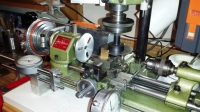I have been making improvements to my 12”x37” geared-head gap bed lathe by removing a small amount of lateral play from the lead screw and feed rod. This type of improvement for the feed rod is not necessary but it does eliminate any machining finish variations due to feed rod vibration.
The lathe has a 8 TPI X .875" diameter lead screw and a 0.748” diameter feed rod. I purchased from Enco 1.480”OD x 0.875” ID and 1.240” OD x 0.750” ID thrust bearings made in the USA (Enco part no. 891-4797 and 891-4798), and pairs of corresponding thrust bearing washers (part no. 891-4804 and 891-4805).
Using 12L14 steel rod, I machined two 0.60” wide collars with 1.250” and 1.500” outer diameters and inner diameters that are 0.001” larger than the lead screw and feed rod diameters. The IDs are for a sliding fit ensuring the collars remain perpendicular to the rods when held in place with brass keys and set screws. I also machined two 0.300” wide protective covers from 12L14 steel and drilled bearing oiling holes with a No. 52 drill. The protective covers have a sliding fit over the collars and are held in place with Loctite 680. The protective covers are temporarily positioned with 0.120” thick brass sections while the Loctite sets.
Each steel collar has 5mm wide by 2.5mm deep keyways that were broached on the lathe using a boring bar and a custom ground HSS cutting tool. The lathe is completely powered-off and engaged in its lowest gear to help prevent turning. In addition, a soft jaw clamp ensures the chuck rotation is locked in position during the broaching process. The cross slide is feed inward 0.001” per “broaching” pass as the boring bar and HSS tool are manually advanced in and out of the collar hole. Using plenty of cutting oil ensures a smooth cut. I used a 0.1970” OD gage pin to check the keyway width before removing the collar from the chuck. Each collar was drilled and taped into the center of the keyway for 8-32 set screws.
I created a square 5mm x 5mm x 0.60” key and rectangular 2.5mm x 5mm x 0.60” key from 1” brass rod. A 5mm thick slice of brass was parted-off from the brass rod using the lathe and then finished to size on my small Unimat lathe with an additional milling head. The brass keys protect the surfaces of the lead screw and feed rod from damage by the 8-32 set screws used to position and lock the collars against the thrust bearings.



 LinkBack URL
LinkBack URL About LinkBacks
About LinkBacks


 Reply With Quote
Reply With Quote




Bookmarks